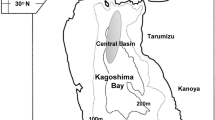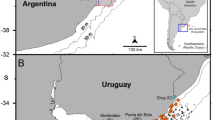Abstract
Population dynamics, demography and body size of the cladoceranBosmina longirostris were examined in an experimental study in which the abundance of its predator (the cyprind fishPhoxinus eos) was varied in an unproductive lake. Four densities of fish were used, encompassing the biomass of fish in the lake.Bosmina was most abundant at low and medium fish densities (1.06 and 2.12 g fish biomass · m-3) and less abundant when fish were either absent or present at high density (3.71 g fish biomass · m-3). The unimodal response to predator abundance resulted from effects on both birth and death rates.Bosmina birth rates increased as fish biomass increased, in response to increasing food (phytoplankton) biomass. Death rates were highest at high fish biomass (because of fish predation) and in the absence of fish (because of predation by the dipteranChaoborus, which was most abundant in the absence of fish). Size-frequency distributions revealed that fish eliminated the larger size classes ofBosmina, and mean carapace length ofBosmina populations was inversely proportional to fish biomass.Bosmina initiated reproduction at smaller size in the presence of fish than in their absence, and size at maturity was inversely proportional to fish biomass. Size at birth also tended to decrease with increasing fish biomass, but this trend was not as strong as that of size at maturity. Decreased size at maturity apparently allowedBosmina individuals to reproduce before becoming vulnerable to fish predation. Flexibility in size at maturity, together with low abundance of invertebrate predators and large herbivores (which were preyed upon by fish), allowedBosmina to become abundant in low and medium fish treatments. In the high fish treatment, mortality due to fish predation was too severe to be offset by decreased size at maturity, andBosmina population density was low. The net response ofBosmina populations to fish predation results from interactive effects of predation on mortality, natality, and life history traits.
Similar content being viewed by others
References
Bartell SM (1982) Influence of prey abundance on size-selective predation by bluegills. Trans Am Fish Soc 111: 453–461
Carpenter SR, Kitchell JF, Hodgson JR, Cochran PA, Elser JJ, Elser MM, Lodge DM, Kretchmer D, He X (1987) Regulation of lake primary productivity by food web structure. Ecology 68: 1863–1876
Culver D (1980) Seasonal variation in the sizes at birth and at first reproduction in Cladocera. In: Kerfoot WC (ed) Evolution and ecology of zooplankton communities. New England Press, Hanover, NH, pp 358–366
DeMott WR (1989) The role of competition in zooplankton succession. In: Sommer U (ed) Plankton ecology: succession in plankton communities. Springer, Berlin Heidelberg New York pp 195–252
Drenner RW, Threlkeld ST, McCracken MD (1986) Experimental analysis of the direct and indirect effects of an omnivorous filter-feeding clupeid on plankton community structure. Can J Fish Aquat Sci 43: 1935–1945
Ebenman B, Persson L, eds (1988) Size-structured populations: ecology and evolution, Springer, Berlin Heidelberg New York pp
Edmondson WT (1972) Instantaneous birth rates of zooplankton. Limnol Oceanogr 17: 792–795
Elser MM, von Ende CN, Soranno P, Carpenter SR (1987)Chaoborus populations: response to food web manipulations and potential effects on zooplankton communities. Can J Zool 65: 2846–2852
Hairston NG Jr (1987) Diapause as a predator avoidance adaptation. In: Kerfoot WC, Sih A (eds) Predation: direct and indirect impacts on aquatic communities. New England Press, Hanover, pp 279–290
He X (1986) Population dynamics of northern redbelly dace (Phoxinus eos), finescale dace (Phoxinus neogaeus), and central mudminnow (Umbra limi), in two manipulated lakes. Masters thesis, University of Wisconsin-Madison
Huntly N (1991) Herbivores and the dynamics of communities and ecosystems. Ann Rev Ecol Syst 22: 477–504
Kerfoot WC, Peterson C (1979) Ecological interactions and evolutionary arguments: investigations with predatory copepods andBosmina. Fortschritte Zool 25: 159–196
Kerfoot WC, Sih A eds (1987) Predation: direct and indirect impacts on aquatic communities. New England Press, Hanover
Leibold M, Tessier AJ (1991) Contrasting patterns of body size forDaphnia species that segregate by habitat. Oecologia 86: 342–348
Lynch M (1979) Predation, competition, and zooplankton community structure: an experimental study. Limnol Oceanogr 24: 253–272
Lynch M (1980) The evolution of cladoceran life histories. Quart Rev Biol 55: 23–42
Lynch M (1989) The life history consequences of resource depression inDaphnia pulex. Ecology 70: 246–256
Menge BM, Sutheriand JP (1987) Community regulation: variation in disturbance, competition and predation in relation to environmental stress and recruitment. Am Nat 130: 730–757
Moore MV (1988) Differential use of food resources by the instars ofChaoborus punctipennis. Freshwater Biol 19: 249–268
Paine RT (1966) Food web complexity and species diversity. Am Nat 100: 65–75
Reynolds CS (1984) The ecology of freshwater phytoplankton. Cambridge University Press Cambridge
Reznick D (1982) The impact of predation on life-history evolution in Trinidadian guppies: genetic basis of observed life history patterns. Evolution 36: 1236–1250
Sih A (1987) Predators and prey lifestyles: an evolutionary and ecological overview. In: Kerfoot WC, Sih A (eds) Predation: direct and indirect impacts on aquatic communities. New England Press, Hanover, NH, pp 203–224
Soranno PA (1991) Zooplankton community dynamics in manipulated lakes. Masters thesis, University of Wisconsin-Madison
Spitze K (1991)Chaoborus predation and life-history evolution inDaphnia pulex: temporal pattern of population diversity, fitness and mean life history. Evolution 45: 82–92
Tessier AJ, Young A, Leibold M (1992) Population dynamics and body-size selection inDaphnia. Limnol Oceanogr 37: 1–13
Urabe J (1991) Effect of food concentration on growth, reproduction and survivorship ofBosmina longirostris (Cladocera): an experimental study. Freshwater Biol 25: 1–8
Vanni MJ (1986) Fish predation and zooplankton demography: indirect effects. Ecology 67: 337–354
Vanni MJ (1987) Effects of food availability and fish predation on a zooplankton community. Ecol Monogr 57: 61–88
Vanni MJ, Findlay DL (1990) Trophic cascades and phytoplankton community structure. Ecology 71: 921–937
Werner EE, Hall DJ (1988) Ontogenetic habitat shifts in bluegill: the foraging rate-predation risk tradeoff. Ecology 69: 1352–1366
Zaret TM (1980) Predation and freshwater communities. Yale University Press, New Haven
Author information
Authors and Affiliations
Rights and permissions
About this article
Cite this article
Vonder Brink, R.H., Vanni, M.J. Demographic and life history response of the cladoceranBosmina longirostris to variation in predator abundance. Oecologia 95, 70–80 (1993). https://doi.org/10.1007/BF00649509
Received:
Accepted:
Issue Date:
DOI: https://doi.org/10.1007/BF00649509




